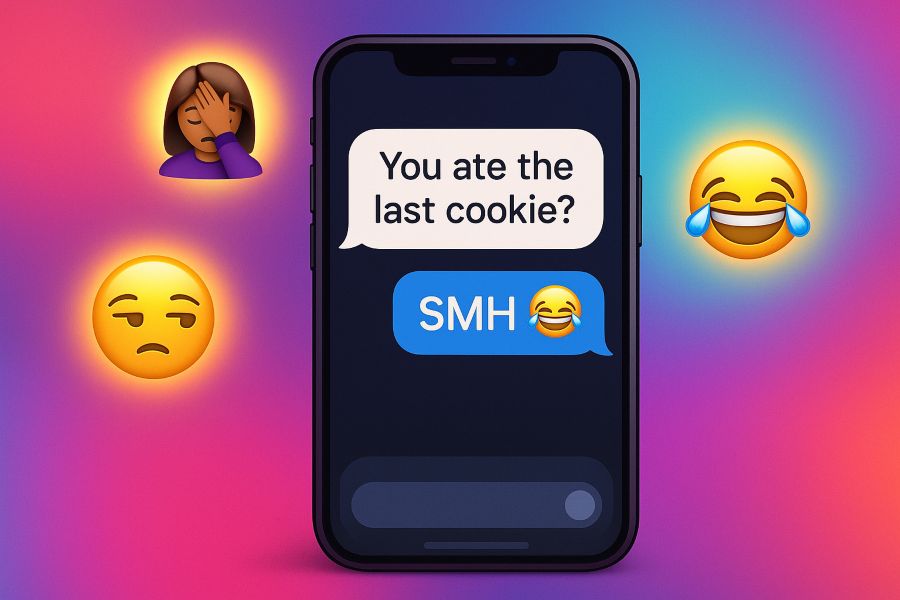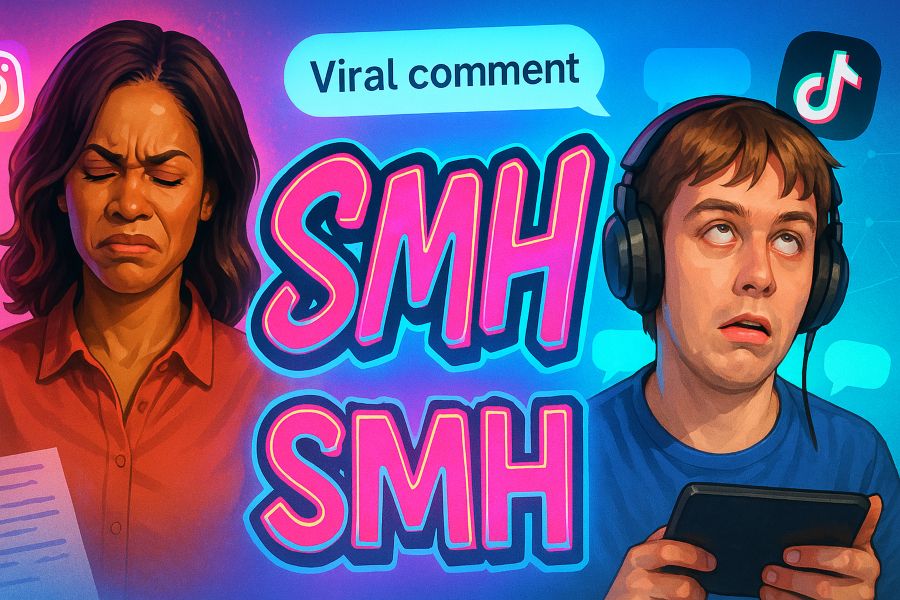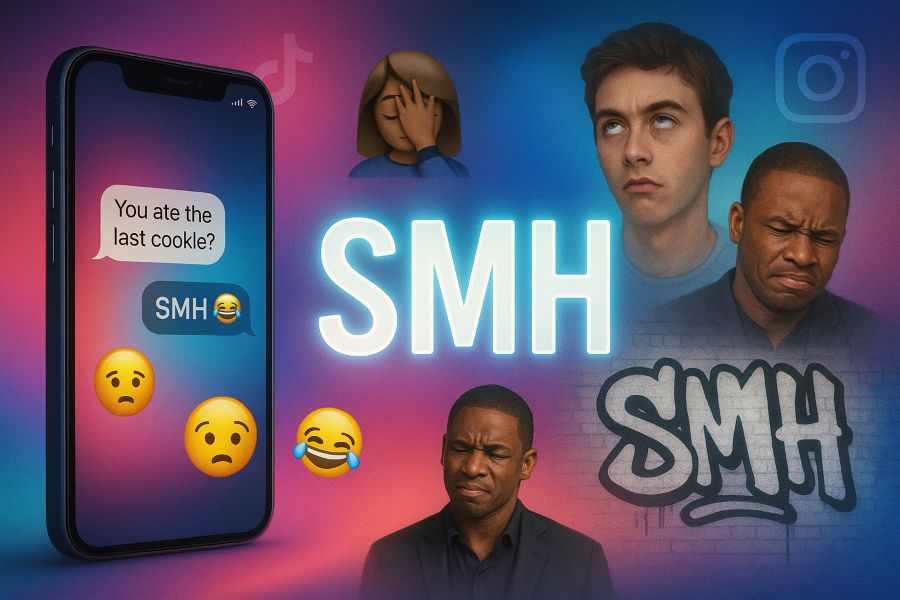The internet moves fast, and so does the language that lives there. Acronyms pop up every day, and some stick around long enough to become part of everyday conversations.
One of those acronyms is SMH, which has been in circulation for well over a decade yet still confuses people who see it for the first time. If you have ever scrolled through TikTok comments, browsed memes, or opened a group chat and suddenly seen “SMH,” you might have paused and wondered what it actually means.
The answer is simple: SMH stands for “shaking my head.” But like most internet slang, the meaning goes deeper than just the literal phrase. It carries emotional context, social nuances, and even generational differences in how it is used.
When someone types SMH, they are not just describing the physical act of moving their head side to side. Instead, they are signaling a reaction—usually disbelief, disapproval, annoyance, or a mix of amusement and judgment.
The phrase has become a staple of digital communication because it says so much while only taking three letters to type. For teens and young adults, it is a shorthand that feels natural in texting and on platforms like Snapchat, TikTok, or Instagram.
For parents, teachers, or ESL learners trying to decode digital slang, it can feel like a secret code that needs translation. Let’s break down exactly what SMH means, how it is used, and why it has remained so popular over the years.
The Core Meaning of SMH

At its heart, SMH is an acronym for “shaking my head.” It is a way to express silent judgment or disbelief without spelling everything out. Instead of typing “I can’t believe you just did that” or “That was a terrible choice,” someone can write “SMH” and get the same point across.
The tone of SMH can vary. Sometimes it is lighthearted, almost like a playful eye-roll between friends. Other times it can show genuine disappointment or annoyance. The flexibility of the acronym is part of why it has lasted so long online. It can fit into casual chats, sarcastic comments, or even serious conversations, depending on the context.
Here are a few examples:
-
Playful disbelief: “You ate the last cookie? SMH 😂.”
-
Annoyance: “He forgot the homework again. SMH.”
-
Disappointment: “SMH, thought you were better than that.”
-
Frustrated humor: “This game crashed for the 5th time today, SMH.”
Notice how the tone shifts depending on the situation. The same acronym adapts easily to different emotional layers.
Emotional Context Behind SMH
Language online is less about strict definitions and more about feelings. SMH is powerful because it communicates an emotion in shorthand. Depending on who uses it, SMH can mean:
-
Disbelief: When someone does something unbelievable or questionable, SMH is the reaction.
-
Disapproval: It signals judgment, like a digital version of frowning or crossing your arms.
-
Annoyance: SMH is an easy way to show irritation without escalating into anger.
-
Playful shade: Sometimes SMH is dropped into jokes, memes, or teasing moments to lighten the mood.
Think of SMH as an online version of non-verbal communication. In real life, you might actually shake your head when your friend makes a poor decision. In texting, SMH lets you express that same reaction instantly.
How SMH Is Used in Text and Social Media
If you’re trying to figure out how to use SMH, it’s essential to look at where it shows up most often. Acronyms like LOL or BRB live in quick, informal chats, and SMH is no different.
-
Snapchat: Often used as a reaction to someone’s story when they post something surprising or questionable.
-
TikTok: SMH dominates the comment section, especially when viewers see content that is funny, cringe-worthy, or over-the-top.
-
Instagram: Under reels or memes, SMH is often dropped in as a sarcastic response.
-
WhatsApp or SMS: In casual group chats, friends use SMH as shorthand to react quickly to something disappointing or silly.
Because it is short and widely recognized, SMH saves time while still communicating clear emotions. It is part of the bigger trend of internet slang evolving to make digital conversations faster and more expressive.
Examples of SMH in Conversations
Let’s look at real-world scenarios where SMH naturally appears in chat.
-
Scenario 1:
Friend 1: “I just texted my ex at 2AM.”
Friend 2: “SMH, you never learn.” -
Scenario 2:
Group Chat: “Bro said pineapple doesn’t belong on pizza. SMH.” -
Scenario 3:
TikTok Comment: “SMH, how are people still falling for this challenge in 2025?” -
Scenario 4:
Parent texting teen: “Why didn’t you clean your room?”
Teen: “SMH, you don’t trust me at all.”
Notice how context changes the meaning. In the last example, the teen is using SMH almost as a defensive phrase, while in others it’s about disbelief or annoyance.
Variations and Related Acronyms
Like most internet slang, SMH has spawned variations and related expressions.
-
SMDH: Stands for “shaking my damn head” and adds emphasis when someone is truly exasperated.
-
SMFH: A stronger version that means “shaking my f**ing head.”*
-
LOL SMH: A hybrid that shows both laughter and disappointment at the same time.
-
🤦 Emoji: Often paired with SMH to visually express a facepalm moment.
These variations add layers of intensity or humor to the basic acronym. Just as people use capital letters for emphasis (SMH vs smh), the expanded forms highlight stronger emotions.
Common Misunderstandings of SMH
Because acronyms evolve online, confusion is common. Some people mistakenly think SMH means something else entirely. Here are a few misconceptions:
-
It does not mean “so much hate.”
-
It is not a typo for “same.”
-
It does not imply extreme anger—it’s more about light frustration or disbelief.
The confusion often comes from new users who see SMH in a chat or meme without any context. That’s why understanding the emotional tone is essential.
The Internet History of SMH
SMH is not a new invention. Its roots go back to early online forums and chat rooms in the early 2000s. Acronym-heavy language was a staple of the early internet, with terms like LOL, BRB, and OMG dominating casual conversations. SMH slowly worked its way into texting culture as phones became more common.
By the 2010s, SMH had fully entered mainstream usage thanks to Twitter and meme culture. It became shorthand in viral tweets and reaction memes, often paired with images of celebrities literally shaking their heads. As TikTok rose in the 2020s, SMH cemented itself in comment sections where short reactions dominate. Even now in 2025, SMH continues to thrive because it is universal, short, and flexible.
SMH in Meme Culture

One reason SMH remains relevant is its role in meme culture. Memes often use simple, recognizable acronyms to convey reactions, and SMH fits perfectly. Popular meme formats include:
-
Videos of someone making a bad decision with the caption: “Me watching my friend do this… SMH.”
-
Reaction images of people rolling their eyes or shaking their heads, paired with SMH text.
-
Captions like “SMH humanity 2025” on viral clips of bizarre internet behavior.
Because memes thrive on quick recognition, SMH continues to be a go-to phrase.
How Parents and ESL Learners Can Understand SMH?
For parents, teachers, or ESL learners, SMH might seem like confusing shorthand. The key to decoding it is remembering that it represents a physical gesture. Imagine someone rolling their eyes or sighing in real life—that’s the energy behind SMH.
Here’s a quick checklist for using or recognizing SMH:
-
Use SMH when you want to show mild frustration or disbelief.
-
Pair it with emojis like 🤦 or 😒 to add more clarity.
-
Keep it short—it works best as a reaction, not a full sentence.
-
Avoid overusing it; too much SMH weakens the impact.
Once you understand the emotion it carries, the acronym becomes easier to spot and interpret.
Why SMH Still Matters in 2025
Internet slang comes and goes, but SMH has lasted because it’s versatile. It adapts across generations, platforms, and tones. Whether in a casual group chat, a TikTok meme, or even sarcastic tweets, SMH delivers a reaction that people immediately understand.
The phrase also highlights how digital language evolves. Acronyms like SMH show how people have created new ways of replicating body language online. Since you can’t literally shake your head in a text, typing SMH gives readers the same mental image. That shorthand has proven so effective that it continues to thrive decades after it first appeared.
Final Thoughts
SMH might seem like a small acronym, but it carries weight in digital conversations. It is shorthand for shaking my head, but its real power lies in the emotions it conveys—disbelief, disapproval, annoyance, or playful shade. From early internet forums to today’s TikTok comments, SMH has stayed relevant because it expresses human reactions quickly and universally.
If you ever come across SMH in a message, just imagine the sender literally shaking their head at the situation. And if you decide to use it yourself, remember that context matters. Used sparingly, it can add humor, sarcasm, or subtle judgment to your conversations without saying too much.


